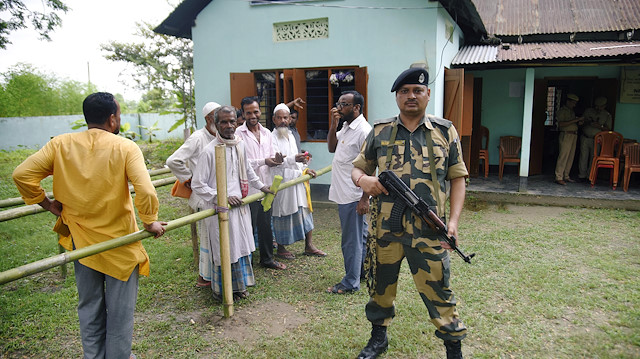
Unexpectedly large number of Hindus in foreigners list flusters Prime Minister Modi government and his party
The recently released citizenship list in India’s northeastern province of Assam has become an albatross around the neck of the ruling Bharatiya Janata Party (BJP), with reports that many of its own voters, Bengali Hindus and Gurkhas, have made their way into the list of illegal immigrants or foreigners.
Since its inception, the party had made detection, deletion from citizenship and voter list, and deportation of illegal Bangladeshi migrants, as part of its core electoral agenda, along with revocation of special status to Jammu and Kashmir, enacting uniform civil code and a promise to build a grand temple in the name of Hindu god Lord Rama at the place of demolished Babri Masjid, in the central Indian city of Ayodhya.
Ironically after the Supreme Court-monitored mammoth exercise, out of total 32.9 million population, just 1,906,657 people were detected as illegal migrants. According to the 2011 census, Assam province has 34.22% Muslim population, the largest after Jammu and Kashmir. The BJP leaders linked this large Muslim population to the illegal migration from neighboring Bangladesh.
Talking to Anadolu Agency from Guwahati, provincial capital of Assam, Aabhijeet Sharma, one of the main petitioners in the Supreme Court, which led to updating of the National Register of Citizens (NRC) in Assam, said the numbers are unexpected.
According to Nityananda Upadhyay, president of the Assam state committee of the Bharatiya Gurkha Parisangha, over a hundred thousand -- around 4% of the total Gorkha population have also been declared illegal migrants. The Gorkhas original natives of Nepal serve in the Indian Army. Their exclusion will have huge ramifications. The ripples will be felt in Nepal and nearby the Darjeeling Hills and other Gorkha-dominated areas in north Bengal.
“We thought numbers of foreigners would be higher. Moreover, there are plenty of cases coming to fore where genuine Indians claim to have been left out of the NRC list. Despite huge expenditures and the hard work of thousands of state government employees, the authority could not produce an error-free NRC. The people of Assam today feel cheated,” said Sharma, who also heads Assam Public Works (APW) party.
He has now applied for a fresh re-verification of the NRC list and is demanding social and financial audit of the entire expenditure incurred in the updating process. It is believed that an amount of 13 billion Indian rupees ($186 million) was spent on the exercise, which spanned over seven years.
Numbers do not match past figures
The All Assam Student Union (AASU), which led a bloody agitation in 80s against outsiders, also said the exclusion does not even match with government’s previous estimates of illegal infiltrators.
“From time to time, the government itself has admitted having over 20 million Bangladeshis in the country with a maximum of them possibly in Assam. But the numbers of those excluded from the NRC list are not even close to anything like that,” he said.
In 2016, the then Minister of State for Home Kiren Rijiju informed parliament that there are around 20 million illegal Bangladeshi migrants staying in India. Rijiju said there are reports of Bangladeshi nationals having entered the country without valid travel documents.
Earlier in 2004, Sriprakash Jaiswal, then junior home minister, said over 12 million illegal Bangladeshi infiltrators were living in different parts of the country. He even said that 5 million were present in Assam alone as of Dec. 31, 2001.
Latest developments have hit the ruling BJP’s important election plank. Initial estimates gathered by volunteers on ground suggest that out of 1.9 million detected as foreigners, 1.1 million are believed to be Hindus and 800,000 Muslims.
The party is now demanding reverification of 20% inhabitants living in seven districts of the Brahmaputra valley, Dhubri, Goalpara, Bongaigaon, Barpeta, Darrang, Nagaon and Morigaon; and, in two of the three districts of Barak valley, Hailakandiand and Karimganj.
Noted commentator Kalyan Barua told Anadolu Agency that in these Muslims concentrated districts, there were less defaulters, because of free legal assistance arranged by several Muslim NGOs and religious groups like Jamiat Ulema-e-Hind (JUH). Local MP, Maulana Badrudin Ajmal, who also heads the All India United Democratic Front (AIUDF) spent days in the interiors, to guide people to prepare documents, the apex court had mandated for proving citizenship.
“The BJP was all for the NRC and deportation of those failing to prove citizenship. But now it has realized that many Bengali Hindus living in Barak Valley have failed to produce documents. It has now starting targeting the whole exercise,” said Barua.
-BJP demands reverification
According to the Assam’s Finance Minister Himanta Biswa Sarma, many Indian citizens who migrated from Bangladesh as refugees prior to 1971, have not been included in the citizenship list because authorities refused to accept their refugee certificates.
“Many names got included because of manipulation of legacy data as alleged by many. I reiterate that as requested by central and state governments, at least 20% re-verification (bordering districts) and 10% re-verification [remaining districts] should be allowed by the apex court for a correct and fair NRC,” said Sarma, who led the BJP to victory in the region.
Many BJP leaders are now demanding a similar exercise should be conducted all over India. They argue that many illegal immigrants have fanned in other states. Keeping in view the time and resources spent on the elaborate exercise in Assam, an all India exercise is estimated to cost 17 trillion rupees ($235 billion), almost equaling to India’s annual revenue that is 20 trillion rupees ($288 billion).
Suhas Chakma, who heads the Rights and Risks Analysis Group (RRAG) maintains that the current exercise was not about identification of foreigners, but a process to punish those who do not have documents of their own or of their forefathers, to prove as residents of Assam prior to March 24, 1971.
Questioning the NRC process, Chakma stated, “with the exception of the Tea Tribes, none of the other communities, linguistic or religious groups in Assam was identified or listed as original inhabitants of Assam. Therefore, all other original inhabitants of Assam have been treated as doubtful citizens and this is the travesty of the NRC process.”
The AIUDF General Secretary Aminul Islam said he was happy with the publication of the list. He alleged that the BJP and its allied organizations were politicizing the issue. “We condemn Himanta Biswa Sarma’s comments mentioning that people praying to Lord Krishna and Goddess Durga have been declared foreigners. One should remember the NRC update was carried out to detect foreigners irrespective of religion,” he said.
He added that the publication of the NRC has provided a specific figure of possible illegal migrants in Assam. He said that his organization will provide legal help to those in the exclusion list, hoping the numbers will be reduced further.
Islam said the illegal foreigners’ issue had been plaguing Assam for over 40 years and the AIUDF was thankful to the Supreme Court for monitoring the matter till the end.
In order to save Hindus being declared foreigners and to prevent their deportation as was stipulated in the NRC exercise, the BJP-led central government is now toying the idea of reintroducing the controversial Citizenship (Amendment) Bill, which seeks to grant Indian citizenship to non-Muslims from Bangladesh, Pakistan and Afghanistan. It was passed by the
Lok Sabha (lower house) in 2017, but failed the Rajya Sabha (upper house) test last year. The proposed legislation lapsed since then.
According to the draft of the Bill Indian citizenship will be granted to the Hindus, Jains, Sikhs, Buddhists and Parsis from Bangladesh, Pakistan and Afghanistan after six years of their residence in India, even if they do not possess any document. "They have no place to go to, except India," said Himanta Sarma.
The move is, however, to create more problems in India’s northeast, where many tribal and indigenous groups are battling for preserving their identity.
“In Assam, the movement was against foreigners irrespective of their religion to prevent local indigenous identity. Therefore, it was decided to declare anyone, who came to Assam after March 1971 an illegal migrant. We do not care if he or she is Hindu or Muslim," said writer Akhil Gogoi.
"Religion is not the issue, it is a question of protecting indigenous people from being swamped by foreigners in their own land. That has been the dominant sentiment in most indigenous communities -- a migrant is unwelcome, regardless of religion. The BJP has failed to understand the pulse of the region, because they see everything through the prism of religion," said analyst Samir Purkayastha.
Assam was one of the better earning regions for the British colonial rulers, who encouraged outsiders to settle in the area to cultivate fertile lands. In 1820s, the Bengalis -- on account of their knowledge of English, were employed in great numbers in Assam's bureaucracy.
The was large influx of foreigners from 1901 to 1971, when Assam's average decadal population growth rate of 23.95% was almost double of All India's 12.90%. But those who came to India before March 24, 1971 have already been accepted as citizens of India as per the Assam Accord of 1985. The Census of India provides that from 1971 to 2011, Assam’s average decadal population growth rate of 20.90% was lower than All India’s of 21.94%. Therefore, there has been no noticeable influx of foreigners during this period.
Another wave of outsiders came to Assam in 1960s and 1970s accentuated by the 1971 Bangladesh Liberation War. An estimated up to 10 million people fled from then East Pakistan to India during this period. The war ended with the creation of Bangladesh but the refugee problem was not addressed satisfactorily. A large number of immigrants were Bengali-speaking Muslims, reviving the acrimony between local Assamese and outsiders with religious identities fueling the fire.
Under the All Assam Students' Union (AASU), a campaign was launched against outsiders alleging that the illegal immigrants were registering themselves as voters. The Congress government divided the new outsiders into categories of refugees and infiltrators. Refugees largely comprised of the Hindus and infiltrators were Muslims.
The agitation saw one of bloodiest massacres on Feb. 18, 1983. At least 2,191 people (unofficial figures run higher) from 14 villages – including Nellie – of Nowgong district in central Assam were killed in the six-hour-long massacre. It came to be known as the Nellie Massacre. An accord was finally signed in 1985, a year after Rajiv Gandhi became the prime minister.
When BJP gained a foothold in Assam, it raised the pitch for NRC and identification and deportation of outsiders. A public interest litigation was filed in the Supreme Court in 2011, which ordered faster implementation of the NRC. The apex court set up a panel and monitored the entire exercise.
The issue has drawn flak from global bodies, who fear India may expel these people, declared outsiders for want of documents. The UN refugee chief urged India to ensure that no one is left stateless or expelled. “Any process that could leave large numbers of people without a nationality would be an enormous blow to global efforts to eradicate statelessness,” Filippo Grandi, the UN high commissioner for refugees, said in a statement issued in Geneva
“A further 200 tribunals will be set up by the state of Assam by December 2019. These tribunals will be set up at the block level for the convenience of appellants,” he said.
India is on horns of dilemma on what to do with those declared foreigners after exhausting the legal processes. Bangladesh has made it amply clear that it will accept these people.
Hours after Assam minister Sarma said that ‘friend’ Bangladesh would be approached to take back its people, Bangladesh Home Minister Asaduzzaman Khan told Indian TV channels that no one from his country had moved to Indian after 1971.
“I repeat, it is India’s internal matter. I do not know who said what in this matter. Let India inform us officially, then we will respond. All I can say is that no one from Bangladesh went to India after 1971. It may be possible that they settled (mainly Bengalis) in Assam from various parts of India itself, but not Bangladesh,” he added.
According to Rights and Risks Analysis Group following countries detected or declared or expelled their inhabitants since 1940s.
1948: Sri Lanka declared 9,75,000 descendants of Indian origin Tamils or the Upcountry Tamils “non-nationals”.
1955: Indonesia declared 100,000 Chinese origin Indonesians as non-citizens after failure of the 1955 Sino-Indonesia Dual Nationality Treaty.
1964: Myanmar expelled 3,90,000 Indian origin people
1971: Bangladesh declared 4,00,000 Bihari Muslims in Bangladesh as non-citizens after liberation
1972: Uganda under Idi Amin expelled 60,000 Indian origin people
1982: Myanmar through a decree made 800,000 Rohingyas stateless
1991: Bhutan expelled 108,000 ethnic Nepalis/ Lhotshampas after declaring them as non-citizens under the 1985 Citizenship Act of Bhutan
2019: India detected 1.9 million ethnic Bengalis as non-citizens.
Hello, the comments you share on our site are a valuable resource for other users. Please respect other users and different opinions. Do not use rude, offensive, derogatory, or discriminatory language.
The floor is all yours.








